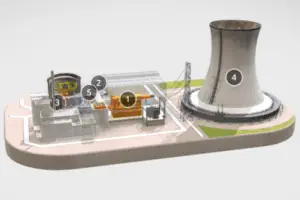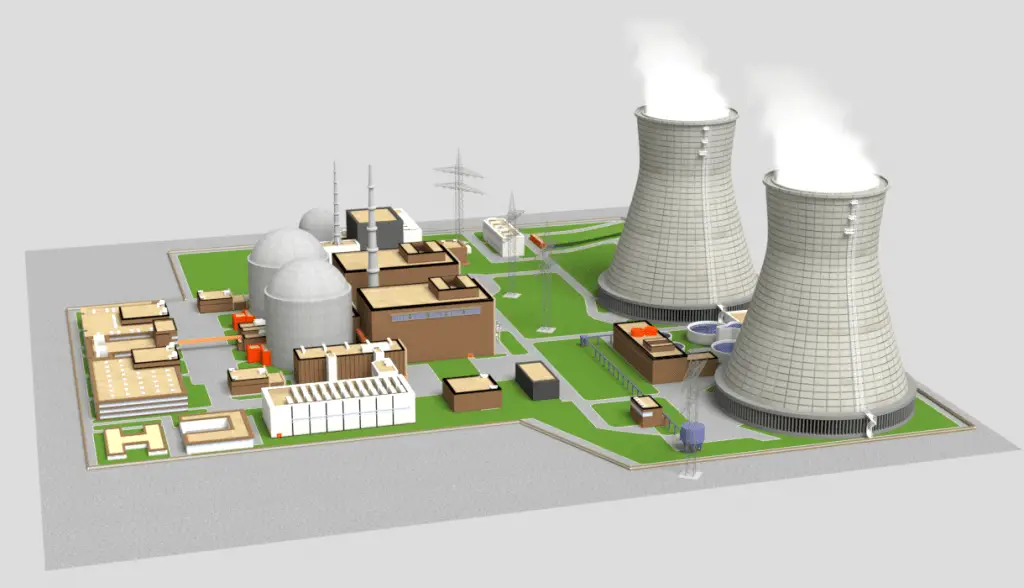Article Summary & FAQs
What is a nuclear power plant?
A nuclear power plant is a thermal power plant in which a nuclear reactor generates large amounts of heat. This heat is used to generate steam (directly or via steam generator) which drives a steam turbine connected to a generator that produces electricity.
Key Facts
- The layout of nuclear power plants comprises two major parts: The nuclear island and the conventional (turbine) island.
- Nuclear reactors in these power plants are “only” used to generate heat. This heat is used to create steam which drives a steam turbine connected to a generator that produces electricity.
- The most common nuclear reactors are light water reactors (LWR), where light water is used as a moderator.
- A typical reactor may contain about 100 tonnes of enriched uranium (i.e., about 113 tonnes of uranium dioxide).
- Typical reactor nominal thermal power is about 3400MW, thus corresponding to the net electric output of 1100MW. Therefore the typical thermal efficiency of its Rankine cycle is about 33%.
- Modern power plants can operate as load-following power plants and alter their output to meet varying demands. But baseload operation is the most economical and technically simple mode of operation.
- In 2011 nuclear power provided 10% of the world’s electricity. In 2007, the IAEA reported 439 nuclear power reactors operating in the world, operating in 31 countries.
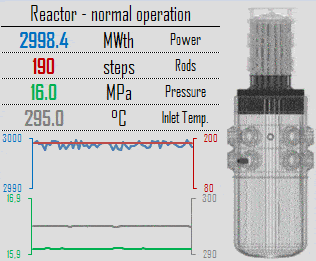
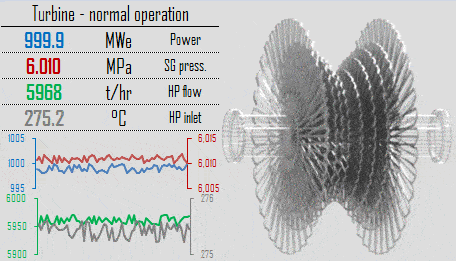
A nuclear power plant is a thermal power plant, in which a nuclear reactor is used to generate large amounts of heat. This heat is used to generate steam (directly or via steam generator) which drives a steam turbine connected to a generator that produces electricity.
The steam turbine is a common feature of all thermal power plants. Steam Turbine was invented in 1884 by Sir Charles Parsons, whose first model was connected to a dynamo that generated 7.5 kW (10 hp) of electricity. An exceptional feature of the nuclear power plant is the nuclear reactor and its safety and auxiliary systems.
Nuclear power plants may take many hours, if not days, to start up or change their power output. It is mainly because they require a long period to heat the nuclear steam supply system and the turbine-generator to operating temperature. Modern power plants can work as load-following power plants and alter their output to meet varying demands. But baseload operation is the most economical and technically simple mode of operation. From this point of view, power plant generally is divided into two basic categories:
Special link: 3D model of NPP – sketchfab.com
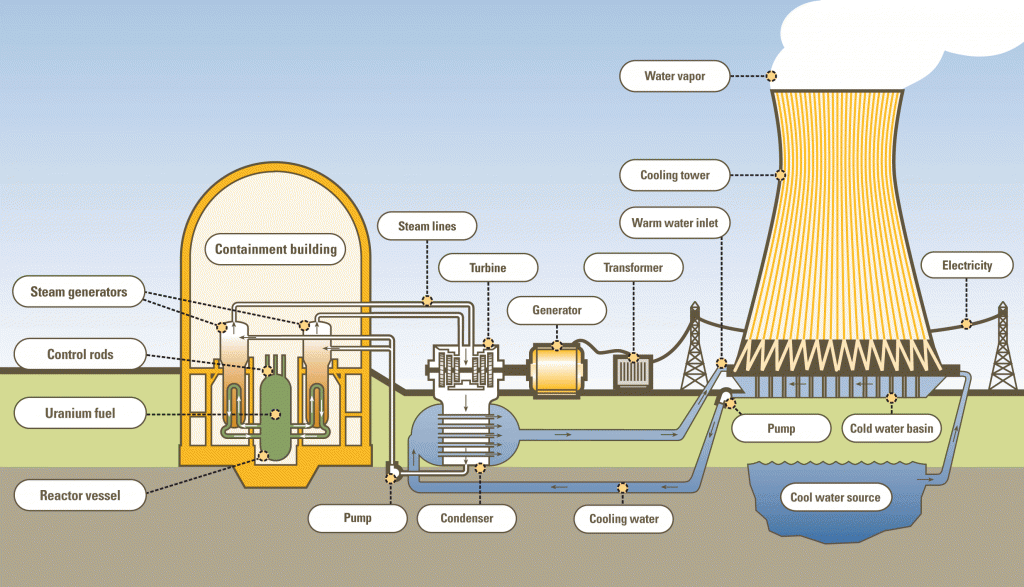
As you can see the nuclear power plant consist of two main buildings:
- Containment building (houses Nuclear Reactor)
- Turbine building (houses Turbo Generator)
The containment building is the key building of the nuclear island. It is an air-tight building, which houses a nuclear reactor and its pressurizer, reactor coolant pumps, steam generators, and other equipment or piping that might otherwise release fission products to the atmosphere in the event of an accident. Such buildings are usually made of steel-reinforced concrete.
The turbine building is the key building of the conventional (turbine) island. The turbine building houses a turbine, generator, condenser, and other equipment used to convert thermal energy from pressurized steam to mechanical work used to drive the generator.
Also a cooling tower can be part of the nuclear power plant, but it is not necessary. Many nuclear power plants (coastal nuclear power plants) do not cool the cooling water via cooling towers.
Components of a nuclear power plant
The key components common to most nuclear power plants are:
- Nuclear Reactor. A nuclear reactor is a crucial device of nuclear power plants. The primary purpose of the nuclear reactor is to initiate and control a sustained nuclear chain reaction.
- Steam Generators. Steam generators are heat exchangers that convert feedwater into steam from heat produced in a nuclear reactor core. They are used in pressurized water reactors (PWR) between the primary and secondary coolant loops.
- Pressurizer. Pressure in the primary circuit is maintained by a pressurizer, a separate vessel connected to the primary circuit (hot leg), and partially filled with water heated to the saturation temperature (boiling point) for the desired pressure by submerged electrical heaters. The temperature in the pressurizer can be maintained at 345°C (653°F), which gives a subcooling margin (the difference between the pressurizer temperature and the highest temperature in the reactor core) of 30°C.
- Reactor Coolant Pumps. Reactor coolant pumps are used to pump primary coolant around the primary circuit. These pumps are powerful, and they can consume up to 6 MW each and be used for heating the primary coolant before a reactor start-up.
- Safety Systems. According to the U.S. Nuclear Regulatory Commission primary objectives of nuclear reactor safety systems are to shut down the reactor, maintain it in a shutdown condition, and prevent the release of radioactive material. Reactor safety systems consist of:
- Reactor Protection Systems
- Essential service water system
- Emergency core cooling systems
- Emergency power systems
- Containment systems
- Steam Turbine. A steam turbine is a device that extracts thermal energy from pressurized steam and uses it to do mechanical work on a rotating output shaft.
- Generator. A generator is a device that converts the mechanical energy of the steam turbine to electrical energy.
- Condenser. A condenser is a heat exchanger used to condense steam from the last stage of the turbine.
- Condensate-Feedwater System. Condensate-Feedwater Systems have two significant functions. To supply adequate high-quality water (condensate) to the steam generator and heat the water (condensate) to a temperature close to saturation.
Manufacturing of Reactor – Youtube

How does Nuclear Power Plant work?
- Nuclear reactors in these power plants are “only” used to generate heat. This heat is used to generate steam which drives a steam turbine connected to a generator that produces electricity.
- Typical reactor nominal thermal power is about 3400 MW. The heat is produced by fission in a nuclear reactor and passes into the primary cooling water.
- For PWRs, the coolant (water) is heated in the reactor core from about 290°C (554°F) to approximately 325°C (617°F) as the water flows through the core.
- The hot coolant is then pumped via main coolant pumps into steam generators.
- In steam generators, this heat is transferred through the walls of these tubes to the lower pressure secondary coolant located on the secondary side of the exchanger where the coolant evaporates to pressurized steam (saturated steam 280°C; 536°F; 6,5 MPa).
- This pressurized steam is then routed into the steam turbine, in which steam expands from pressures about 6 MPa to pressures about 0.008 MPa. Steam turbines in western nuclear power plants are among the largest steam turbines ever.
- The steam turbine is connected to the main generator, which generates electricity.
Most nuclear power plants operate a single-shaft turbine-generator that consists of one multi-stage HP turbine and three parallel multi-stage LP turbines, the main generator and an exciter. HP Turbine is usually a double-flow impulse turbine (or reaction type) with about ten stages with shrouded blades and produces about 30-40% of the gross power output of the power plant unit. LP turbines are usually double-flow reaction turbines with about 5-8 stages (with shrouded blades and free-standing blades of the last three stages). LP turbines produce approximately 60-70% of the gross power output of the power plant unit. Each turbine rotor is mounted on two bearings, i.e., there are double bearings between each turbine module.
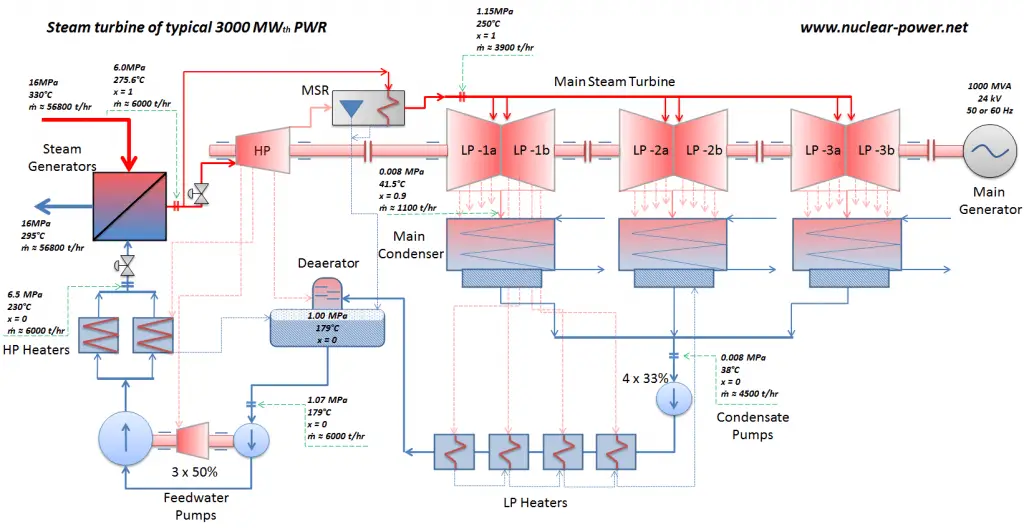
Thermal Efficiency of Nuclear Power Plant
In modern nuclear power plants, the overall thermal efficiency is about one-third (33%), so 3000 MWth of thermal power from the fission reaction is needed to generate 1000 MWe of electrical power. The reason lies in relatively low steam temperature (6 MPa; 275.6°C). Increasing the temperature of the steam can attain higher efficiency. But this requires an increase in pressures inside boilers or steam generators. However, metallurgical considerations place an upper limit on such pressures. In comparison to other energy sources, the thermal efficiency of 33% is not much. But it must be noted that nuclear power plants are much more complex than fossil fuel power plants, and it is much easier to burn fossil fuel than to generate energy from nuclear fuel. Sub-critical fossil fuel power plants operating under critical pressure (i.e., lower than 22.1 MPa) can achieve 36–40% efficiency.
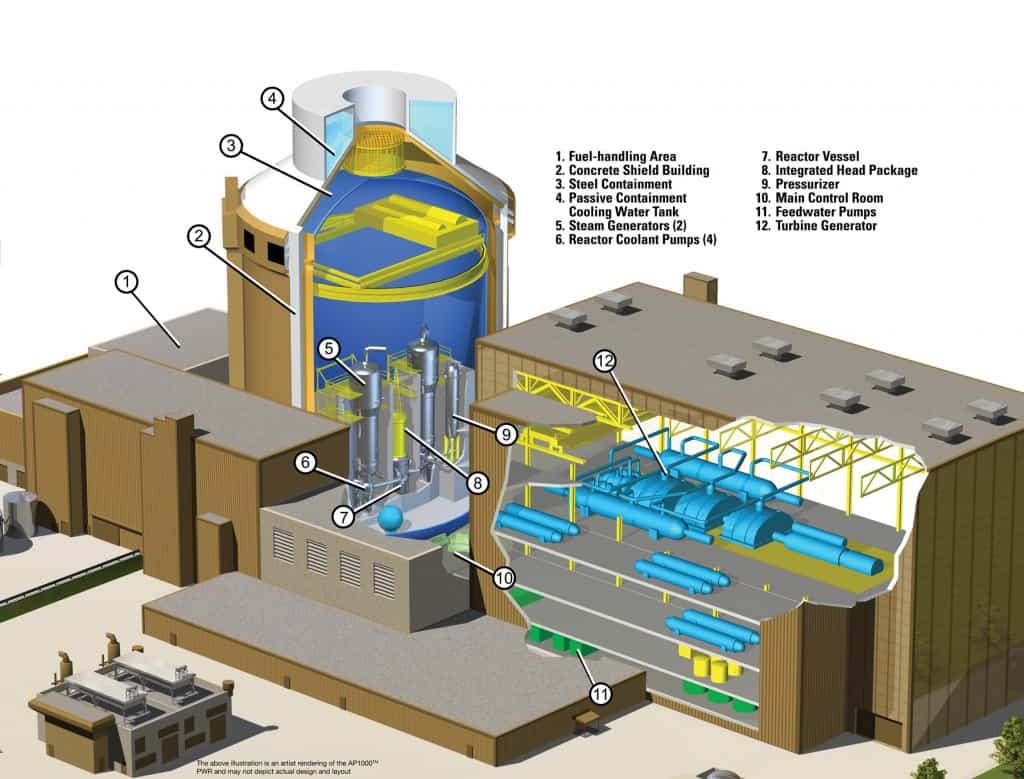
Source: www.todaysengineer.org/
The Database on Nuclear Power Reactors by IAEA
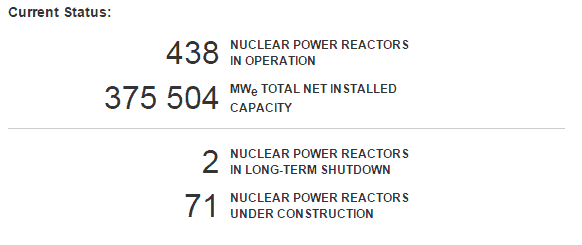
Source: www.iaea.org/pris
The Power Reactor Information System (PRIS), developed and maintained by the IAEA for over four decades, is a comprehensive database focusing on nuclear power plants worldwide. PRIS contains information on power reactors in operation, under construction, or those being decommissioned.
The database covers:
- Reactor specification data (status, location, operator, owner, suppliers, milestone dates) and technical design characteristics
- Performance data, including energy production and energy loss data, outage, and operational event information
See also: PRIS by IAEA
See also:
